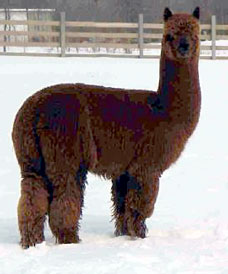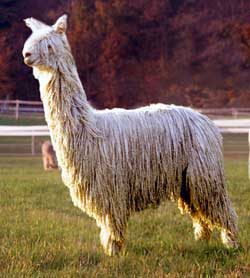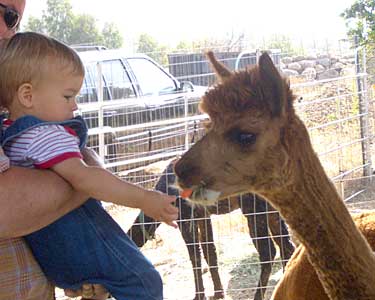Step Closer...
The rare and exotic alpaca is a creature
of antiquity that is rapidly gaining popularity around the world. Highly
prized for their luxurious coats, the alpaca has been considered a treasure
of the Andes Mountains for over 6,000 years.
Alpacas are New World camelids and look like small llamas or long-necked
camels with no humps, especially when recently sheared. They have shaggy
necks and camel-like faces with thick lips, pronounced noses, and long
ears. Their large, expressive eyes seem to exhibit both wisdom and childlike
curiousity. Easily domesticated, alpacas are friendly, gentle and curious.
Alpacas were exported from Peru in the mid-1980s and have become a
premier livestock in North America and abroad. In the United States,
the national Alpaca
Registry (ARI)
was formed to ensure breed purity and high standards. Importation from
South America is now closed.
Each alpaca born in the US is blood-typed before registering. This practice
helps keep our North American standards high, our animals healthy, and
our breeding practices more focused on growing the best alpaca fiber
in the world.

huacaya
fleece ~ note the crimp
 |
Fleece
The hair of the alpaca is called 'fleece'
or 'fiber' rather than 'fur' or 'wool.' Alpaca fleece has 22 natural
shades ranging from black to silver and rose gray and white, from mahogany
brown to light fawn and champagne. Alpacas can be bred for specific color.
There are two types of alpacas, classified according to their fiber
type:
- Huacaya ('wah-KI-yah') — dense, crimped, wooly, water-resistant
fleece. About 90% of all alpacas in the North America are "teddy-bear" huacayas.
- Suri ('SUR-ree') — very fine and lustrous fiber which
grows parallel to the body in long, separate locks. Only 10% of the
alpaca population in the US are suris.
Huacaya and Suri alpacas
 |
 |
Unlike the llama, the fiber of the alpaca
can be used for clothing. Alpaca fiber is softer than cashmere or
angora, and warmer and lighter weight than wool, without the prickle-factor
that some wool has. Since alpaca fleece has no lanolin, it is easier
to process and is hypoallerginic.
| Color Key |
W = White
|
|
LB = Light Brown |
|
LSG = Light Silver Grey |
| B = Beige |
|
MB = Medium Brown |
|
LRG = Light Rose Grey |
| LF = Light Fawn |
|
DB = Dark Brown |
|
MSG = Medium Silver Grey |
| MF = Medium Fawn |
|
BB = Bay Black |
|
MRG = Medium Rose Grey |
| DF = Dark Fawn |
|
TB = True Black |
|
DSG = Dark Silver Grey |
| |
|
|
|
DRG = Dark Rose Grey |
Alpacas are sheared annually, usually in the spring. The fiber may be
sold and processed into rovings, spun into yarn, knitted or woven into
fine fabrics. Each step adds more value to the product.

Personality
 Like all animals, alpacas exhibit individual personality. They are herd
animals, preferring the companionship of their friends and their established
community, and will become stressed if separated from their buddies. Like all animals, alpacas exhibit individual personality. They are herd
animals, preferring the companionship of their friends and their established
community, and will become stressed if separated from their buddies.
Observe who is always first at the food bins, and who is last. Notice
when a female is extra-friendly — she may have lost her pregnancy
and is wanting to be re-bred. Some cria exhibit independence at an early
age, others may be momma's kids, just like two-leggeds.
Gentle and curious, alpacas respond well to children, and many ranches
are a family affair. A confident youngster can handle an animal
in the showring or on an obstacle course. Regional events sometimes offer
a costume
contest. Alpacas are well-suited for 4-H projects to learn animal
husbandry. During winter holidays you may even see a couple of them stand
in for their camel cousins in a Nativity scene.

History
The oldest known records of these charming creatures was 1,000 years
before the great pyramids of Giza. The Inca nobles demonstrated their
wealth by the number of alpacas they owned and by showing off their beautiful
garments woven from soft alpaca fleece. A thriving Peruvian economy emerged
and continued for thousands of years with these magical animals creating
wealth and prosperity for their Inca owners.
When the Spanish Conquistadors conquered the Inca Empire in the 17th
century, the Indians sought refuge the heights of the Andes and took
with them a limited number of these precious animals. Consequently, alpacas
escaped extinction, and they are now plentiful in wild herds at about
3.5 million strong. Indians of the Andes continue to shepherd them.
 In Peru in the 1940's, Don Julio Barreda purposefully
began to breed alpacas toward better fiber and specific color. He utilized
better nutrition by fencing his herd and rotating pastures. By paying
careful attention to genetics, he created distinct herds of both huacaya
and suri alpacas, and culled out llama genes. Today he is recognized
industry-wide as the world's finest alpaca breeder. "Accoyo" alpacas
are from the bloodline of his Peruvian herd. In Peru in the 1940's, Don Julio Barreda purposefully
began to breed alpacas toward better fiber and specific color. He utilized
better nutrition by fencing his herd and rotating pastures. By paying
careful attention to genetics, he created distinct herds of both huacaya
and suri alpacas, and culled out llama genes. Today he is recognized
industry-wide as the world's finest alpaca breeder. "Accoyo" alpacas
are from the bloodline of his Peruvian herd.
In spite of their rich history, alpacas were not well-known worldwide
until recently. The first imports into the United States were in 1983,
and now they have been imported into every major country. For more information,
see the World & North
American Census.

FAQs
Q: Is alpaca fiber really useful?
A: Alpaca fleece is a premium fiber and in high demand in the fashion
industry. It is light-weight, warm, durable, soft and not itchy. Handspinners
appreciate its quality, and handcrafters find it easy to work with. The natural
hues are highly desirable, yet light colors readily accept dye. Many ranches
have small stores selling yarn from their own animals or clothing and accessory
products crafted from the fleece.
Q: What's the difference between alpacas and llamas?
A: Size and fiber quality. Llamas were primarily
bred to be beasts of burden, and alpacas were bred primarily as
fiber producers. An average alpaca stands 34"-36" at the
withers (shoulders), whereas a llama stands 42"-48" at
the withers.
Alpacas weigh 125-175
pounds on average. An adult alpaca will generally produce 5-8 pounds
of high-quality fiber each year. >>
links to more info>>
Q: How long do alpacas live?
A: Alpacas have a life expectancy of about 20 years.
Q: When do they reach breeding maturity?
A: Females reach breeding capability by 16-24 months. Males
usually don't reach sexual maturity until 24 months or more, with the rare one
becoming potent as early as 12 months.
Q: What is the gestation period?
A: The gestation period is 11-1/2 months (~350 days).
Q: When do females stop breeding?
A: With good nutrition and time off every few years, females will breed throughout their life.
Q: How much do the babies weigh when born?
A: Alpaca
crias average 15-18 lbs. Delivery usually occurs during the daytime and
rarely requires the assistance of humans. Twins are extremely rare.
Cria are weaned at about 6 months of age.
Q: What do alpacas eat?
A: The alpaca is an herbivore, grazing on grass and munching weeds,
shrubs and trees. They process their food through 3 stomachs where special
secretions enable the animal to absorb 50% more nutrients than sheep. Low-protien
feed is recommended, with additional mineral supplements for females since they
are generally pregnant and/or nursing.
Q: Do alpacas spit?
A: Not very often and usually only at each other, to signal displeasure at a
herd member. A pregnant female 'spits off' an inquisitive male to let him know
she is disinterested in his advances.
Q: What predators threaten alpacas?
A: The alpaca is prey to mountain lions, coyotes, bears, and other carnivores.
In its native Andes, the alpaca's long neck helps spot predators among
the rocks of the mountain slopes. On US ranchs, llamas, donkeys, and guard dogs
such as Anatolian
shepherd dogs are often used as herd guardians.
Q: What sounds do alpacas make?
A: Humming is the most common sound an alpaca makes, a sort of musical
purring. The mom calls to her cria by humming, or they hum to communicate with
each other within the herd.
When alarmed, a staccato tooting is made by one animal, then joined
in by the rest of the herd as they focus attention in the direction of potential
danger.
During breeding, which lasts from 20 to 30 minutes, a male trumpets
or 'orgles' a lovesong to his mate.
Q: Is their manure good fertilizer?
A: Their manure is excellent fertilizer and may be applied directly
to the garden without danger of 'burn.' Because alpacas are not nomadic, they
mark their territory with their dung piles and usually wait to get to the
designated area to defecate or urinate.
Q: Are alpacas environmentally friendly?
A: The alpaca's two-toed feet are soft
pads protected on the top and sides by toe nails. Unlike hard hooves, they
leave the terrain undamaged. And as they graze, they only nibble the top of
the pasture grass rather than uprooting it. By rotating between two or three
pastures, there is always a fresh supply of grass.
|